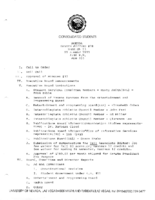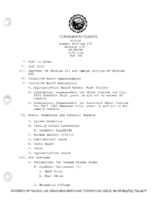Search the Special Collections and Archives Portal
Search Results
Jay Sarno Papers
Identifier
Abstract
This collection is comprised of publicity and promotional materials documenting the Caesar's Palace Hotel and Casino Resort and the Circus Circus Hotel and Casino Resort. Both resorts were a result of hotel and casino developer Jay Sarno. There is a small amount of material on Sarno in the collection such as newspaper clippings, a press release, and a copy of Sarno's FBI investigation file. The collection includes property records, magazine and newspaper clippings, informational brochures from the two properties, press kits, and a small amount of correspondence. It also includes a prospectus and stock offerings for Sarno's never-realized Grandissimo Hotel and Casino resort that would have been built on Interstate 15 to the west of the Las Vegas Strip.
Archival Collection
Minsky's Burlesque Records
Identifier
Abstract
Minsky's Burlesque Records (1922-1978) contain scripts, publicity, photographs, financial records, payroll records, sheet music, newspaper clippings, contracts, and correspondence. Also included are the personal papers of noted burlesque producer Harold Minsky, who was known for creating the "family burlesque" style of entertainment and for introducing the topless showgirl to Las Vegas, Nevada at the Dunes Hotel in 1957.
Archival Collection
McCall Family Papers
Identifier
Abstract
The McCall Family Papers are comprised primarily of family photographs and correspondence from 1910-1970. The materials concentrate on Quannah McCall and his daughter, Connie McCall, both were well known dentists in Southern Nevada. The materials also contain letters, postcards, holiday cards, and birth, death, and marriage certificates, as well as school commencement announcements for family members.
Archival Collection
Chester Longwell Photograph Collection
Identifier
Abstract
The Chester Longwell Photograph Collection consists of 608 black-and-white photographic prints dating from approximately 1910 to 1930. The images primarily depict the Longwell family's excursions in the Southern Nevada region, primarily to Mount Charleston, Nevada. Also included are images of Southern Nevada mines and mining towns, as well as Pubelo Grande de Nevada, the Lost City. The remaining images depict geological formations and features, as well as forestry and nature scenes in Nevada and Arizona.
Archival Collection
Ernie W. and Lucille Marleau Cragin Photograph Collection
Identifier
Abstract
The Ernie W. and Lucille Marleau Cragin Photograph Collection contains photographic prints, negatives, and slides depicting early Las Vegas and Boulder City, Nevada events, buildings, and people between approximately 1900 and 1950.
Archival Collection
Binion’s Horseshoe Club Photograph Collection
Identifier
Abstract
The Binion’s Horseshoe Club Photograph Collection dates between approximately 1940 to 1985 and contains black-and-white and color photographic prints and negatives depicting Benny Binion’s family, friends, and Binion’s Horseshoe Club, also known as Binion’s Hotel and Casino, Binion's Horseshoe, and Binion's Gambling Hall. Photographs of Binion’s family and friends show them posed at Binion’s casino property, Binion Ranch, and events including rodeos and the Helldorado parade. Binion’s Horseshoe photographs include views of street scenes and billboard advertisements featuring Binion’s Horseshoe, the Million Dollar Display, quarter horse sales, World Series of Poker events, Binion’s Horseshoe stagecoach, and celebrities visiting the property.
Archival Collection
Pueblo Grande de Nevada Photograph Collection
Identifier
Abstract
The Pueblo Grande de Nevada Photograph Collection (approximately 1920-1980) contains black-and-white photographic prints, negatives, and slides depicting archaeological sites located in Overton, Moapa, Valley of Fire, Red Rock, Pyramid Lake, Kane Springs, Virgin River, the “Lost City,” and Lake Mead, Nevada. Images display the different stages of digging during the archaeological excavation of Pueblo Grande de Nevada. Also included are images showcasing artifacts uncovered during the excavations, the Saint Thomas, Nevada and the flooding of archaeological sites after the construction of the Hoover (Boulder) Dam.
Archival Collection
University of Nevada, Las Vegas Creative Services Thematic Slides and Prints
Identifier
Abstract
This is part 6 of 6 finding aids for the University of Nevada, Las Vegas Creative Services Records (1959-2016). Generally, materials are transferred from UNLV Photo Services to UNLV Special Collections and Archives 5 years after they are created. For materials within the last 5 years, contact photo@unlv.edu or call 702-895-3036. This finding aid contains the thematic slides, contact sheets, and audiovisual materials taken and used by UNLV Creative Services for publicity and promotional purposes from approximately 1959 to 2009. The majority of the materials consist of images from various academic departments, athletics, buildings and historical views of campus, as well as faculty and student life. Also included in the collection are an assortment of print materials, such as theater and music programs, as well as audio cassettes and film reels from anniversary events around campus.
Archival Collection

Meeting minutes for Consolidated Student Senate, University of Nevada, Las Vegas, August 09, 1983
Date
Archival Collection
Description
Text

Meeting minutes for Consolidated Student Senate, University of Nevada, Las Vegas, June 28, 1983
Date
Archival Collection
Description
Text
